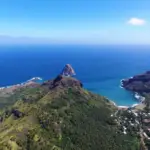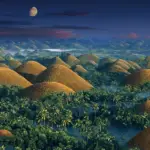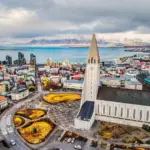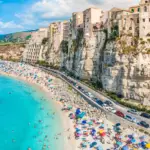
Introduction
Exploring the magic of the Faroe Islands: a remote and enchanting archipelago in the North Atlantic
The Faroe Islands, located in the heart of the North Atlantic, are a true hidden gem offering a unique experience for travelers seeking adventure and unspoiled natural beauty. Comprising 18 main islands, this remote archipelago is home to stunning landscapes, a rich cultural heritage, and a welcoming community. Amidst the vastness of the ocean, the Faroe Islands rise majestically with their rugged mountains, deep fjords, and lush valleys.
A brief dive into the fascinating history of the Faroe Islands
The Faroe Islands' origins can be traced back more than a millennium. According to ancient legend, Norse settlers arrived on the islands in the early decades of the ninth century. This Viking influence is still evident today in the Faroese language and cultural traditions passed down through the centuries.
For many years, the islands were subject to Norwegian and Danish sovereignty before finally gaining internal autonomy in 1948. This tumultuous history has left its mark on the traditions and character of the Faroese people.
The locals have a strong sense of identity and pride in their roots, which is reflected in their vibrant culture and preservation of ancestral traditions. Traveling to the Faroe Islands, you'll have the opportunity to explore the fascinating intersection between past and present, witnessing the evolution of a nation that embraces its history while moving toward the future.
Discovering the Faroe Islands
Situated between Norway and Iceland, the Faroe Islands are strategically positioned to offer stunning panoramic views of the North Atlantic. With a total area of about 1,400 km², this picturesque archipelago is made up of distinct islands – each with its own unique character.
Torshavn, the capital of the Faroe Islands, is a major tourist attraction and a vibrant cultural hub where you can discover the region's rich history. Now it's time to embark on an exciting journey through the unexplored Faroe Islands.
Come with us as we immerse ourselves in the natural wonders of this remote paradise and we discovered the secrets hidden within its majestic cliffs and misty fjords. Prepare to be captivated by the untouched beauty of this magical place where the past harmoniously intertwines with the present.
Geography and Climate
The Mountain Landscape: Steep Cliffs, Deep Fjords and Green Valleys
The Faroe Islands are truly a stunning visual spectacle, with their unique mountainous landscape. The archipelago's topography is characterized by steep cliffs that rise majestically above the sea, creating stunning views for visitors. These dramatic cliffs, such as the famous Drangarnir and Trælanípan, provide a cinematic backdrop for adventurers seeking to explore the wilderness.
In addition to the impressive cliffs, the Faroe Islands are also home to deep, narrow fjords that wind through the landscape. These unique geographical features offer an experience unique navigation for fearless navigators.
The fjords are not only beautiful to admire, but also play a vital role in the lives of the islanders, providing important transportation routes and rich fish habitats. While cliffs and fjords dominate the islands' coastline, their interior is adorned with lush green valleys.
These areas of lush vegetation provide refuge for a variety of flora and fauna endemic to the Faroe Islands. Walking through the valleys is like entering an enchanted world, where crystal-clear streams meander between verdant hills dotted with colorful wildflowers.

Unpredictable Weather: Strong Winds, Persistent Fog, and Frequent Rainfall
The Faroe Islands are famous for their unpredictable and challenging weather, which adds a layer of mystery and charm to the experience of visiting the archipelago. Strong winds from the North Atlantic constantly sweep across the islands, creating a dynamic and invigorating environment. These powerful gusts can be felt throughout the region, providing a true test for lovers of nature. outdoor activities.
Persistent fog is another striking feature of the Faroe Islands' climate. It shrouds the landscapes in an ethereal aura, lending a magical touch to the environment.
The fog creates a unique atmosphere that can completely alter the appearance of a landscape in a matter of minutes. Furthermore, frequent rainfall is a constant feature of the islands' climate.
The sky often breaks into heavy downpours that can seem endless to unprepared visitors. However, these abundant rains are also responsible for the islands' rich, verdant vegetation.
In short, the Faroe Islands offer spectacular geography with steep cliffs, deep fjords, and vibrant valleys. Their unpredictable climate brings strong winds, persistent fog, and frequent rains to complete the unique landscape of these enchanting North Atlantic islands.

The Viking Heritage of the Faroe Islands
The culture of the Faroe Islands is deeply rooted in Viking heritage, which can be seen in many aspects of the inhabitants' daily lives. The Faroese language, for example, is an Old Norse language derived from Old Norwegian, preserving many linguistic elements from that period. It is fascinating to see how the language developed and survived over the centuries in the Faroe Islands.
The traditional music of the Faroe Islands, known as kvæði, also reflects Viking heritage. These folk songs are characterized by ancient melodies and lyrics that tell stories of heroism and bravery.
The verses are often sung a cappella at religious ceremonies or special social events, transporting audiences to a bygone era. Furthermore, traditional Faroese folk dances captivate visitors with their captivating and energetic choreography.
A particularly notable dance is the "Faroese chain dance," in which dancers form a human chain, intertwining their arms while performing coordinated movements to vibrant music. This dance symbolizes unity among people and the collective strength of the Faroese community.
How to get to the Faroe Islands
Some airlines that fly to the Faroe Islands are:
- Atlantic Airways: is the flag carrier of the Faroe Islands and the only airline that flies regularly to Vagar Airport, the only airport on the islands.
- Scandinavian Airlines (SAS): is an airline from Sweden, Denmark and Norway that also offers flights to the Faroe Islands.
- Other airlines: You can find flights to the Faroe Islands with other airlines, such as KLM, the Lufthansa and the Air France, which connect to other countries.
- It is important to remember that there are no direct flights from Brazil to the Faroe Islands, so a connection in another country is required.
where to stay in the Faroe Islands
When choosing where to stay in the Faroe Islands, it's important to consider several factors, such as location, amenities, and access to tourist attractions. Here are some accommodation options in the Faroe Islands:
- Tórshavn: The capital of the Faroe Islands, Tórshavn, offers a variety of accommodation options, from luxury hotels to more affordable guesthouses. Staying in Tórshavn allows easy access to the city's restaurants, shops, and tourist attractions.
- Klaksvík: Located on the island of Borðoy, Klaksvík is the second largest city in the Faroe Islands. It's an interesting option for those looking to explore the natural beauty of the region, such as mountains and fjords.
- Vagar: The island of Vágar is home to Vagar Airport, the main entry point to the Faroe Islands. Staying in Vágar can be convenient for those who want to explore the island and its attractions, such as Lake Sørvágsvatn and the town of Sørvágur.
- Gjógv: Gjógv is a small village located on the island of Eysturoy. It is known for its grass-roofed houses and beautiful landscapes. Staying in Gjógv offers a peaceful and picturesque experience.
- Sørvágur: Sørvágur is a town on the island of Vágar, close to Vágar Airport. It's a convenient option for those arriving or departing from the Faroe Islands by plane.
It's important to book accommodations in advance, especially during the summer months when the Faroe Islands receive a higher number of tourists. Also, check the cancellation policies and amenities offered by hotels before booking. Keep in mind that accommodation information can change over time, so it's a good idea to check updated hotel booking sites and read reviews from other travelers to make an informed decision about where to stay in the Faroe Islands.
what to do in the Faroe Islands
If you're planning a trip there, here are some things you can do:
- Visit tourist attractions: There are several tourist attractions in the Faroe Islands, such as Mulafossur Waterfall, the Cleft Of Gjogv, the bird cliffs of Vestmanna, Saksun Church and the village of Funningur.
- Driving: The best way to get around the Faroe Islands is by car. Since car rentals are limited, it's recommended to rent a car before arriving on the island.
- Boat trip: Boating is one of the best ways to enjoy the Faroe Islands' scenery. Fishing is also available on some tours.
- Explore nature: The Faroe Islands are known for their stunning natural landscape, with mountains, fjords, and waterfalls. There are several hiking trails that allow you to explore the region's natural beauty.
- Know the local culture: The Faroe Islands have a rich and unique culture, with traditions such as whaling and polyphonic singing. You can visit museums and art galleries to learn more about the local culture.
- Try the local cuisine: Faroese cuisine is based on seafood and sheep meat. Several restaurants serve typical regional dishes, such as ræst, fermented sheep meat.
Remember that the Faroe Islands are a remote destination with unpredictable weather, so it's important to prepare well for your trip and be prepared for changes in plans.
The importance of fishing in local traditions
In the Faroe Islands, fishing plays a fundamental role in the archipelago's history, culture, and economy. For centuries, the islanders have developed remarkable fishing skills and built an intrinsic relationship with the sea.
A unique tradition worth highlighting is Grindadráp, a traditional method of group whale hunting. Although controversial from an environmental perspective, Grindadráp has deep historical roots and is considered by locals to be a sustainable way to obtain food for the community.
Hunting is carried out annually under strict regulations to ensure species preservation. Furthermore, general fishing plays a vital role in the Faroe Islands' livelihood and economy.
The fishing industry generates a large portion of the archipelago's income and employs many Faroese. Catching fish such as cod and salmon not only provides fresh food for the people but also contributes to the export of these products, strengthening the local economy.
Popular festivals such as Ólavsøka
The Faroe Islands' vibrant culture comes to life through festivals celebrating local customs. One of the most important events is Ólavsøka, which celebrates the archipelago's independence. The festival takes place annually on July 29th, honoring Saint Olav, the islands' patron saint.
Ólavsøka is a celebration that brings together the Faroese community in a series of cultural, musical, and sporting activities. During the festival, residents dress in colorful traditional costumes and participate in folk dances, sporting competitions such as the Viking boat race, and exciting musical performances.
Ólavsøka is also a great place to savor local culinary delicacies, such as ræst kjøt (smoked meat) and skerpikjøt (dried meat). These culinary delights are prepared using traditional techniques passed down through generations.
Conclusion
The Faroe Islands enchant visitors with their rich culture, rooted in Viking heritage. The Faroese language preserves ancient linguistic roots, while traditional music and folk dances transport people to a bygone era. Fishing plays a key role in local traditions, from the controversial Grindadráp to the fishing industry that sustains the community.
And festivals like Ólavsøka celebrate Faroese identity with vibrant dances and traditional culinary delights. The Faroe Islands are a cultural treasure trove that deserves to be explored and enjoyed by anyone seeking a unique and authentic experience.
Lucas Wanderlust has a tireless spirit of adventure, always seeking new travel experiences. Fascinated by the world and the possibility of exploring unknown destinations, he fell in love with the sense of freedom and self-discovery that traveling alone provides. With a backpack on his back and a heart open to the unknown, Lucas embarks on exciting journeys, where each destination becomes a unique chapter in his life story. He gives himself body and soul to the magic of solo travel, inspiring others to follow in his footsteps and discover themselves through adventure.







